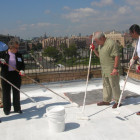Federal weatherization funding can be used to address not only the energy efficiency of buildings but also their financial sustainability, resident health and safety, all while upgrading green skills for workers.
While the establishment of programs like Green Jobs Green New York has certainly helped scale up programs that use weatherization to attack a set of urban ills, there remains work to be done.
Even in poor neighborhoods not home to power plants, waste transfer stations or the other egregious environmental offenders, physical conditions sustain not just ill health, but poverty as well.
The environmental progress New York City—and Brooklyn especially—have made reflects federal legislation and local infrastructure. But it’s also been a story of community groups working to make their neighborhoods healthier.
What role do neighborhood groups play in the global effort to save the environment? What does sustainable living offer to low-income New Yorkers? We asked the experts.





